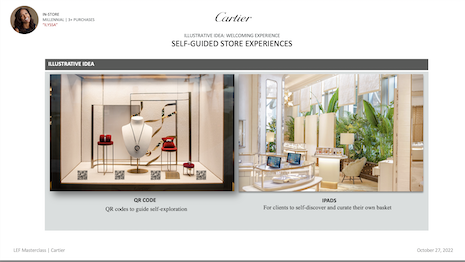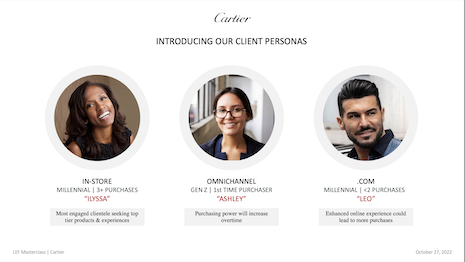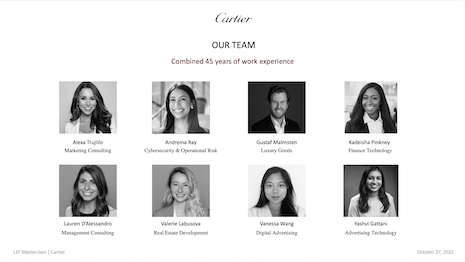 Self-guided store experiences can help elevate the Cartier client experience: recommendation from Columbia MBA LEF class to Cartier. Image credit: Cartier, Luxury Education Foundation
Self-guided store experiences can help elevate the Cartier client experience: recommendation from Columbia MBA LEF class to Cartier. Image credit: Cartier, Luxury Education Foundation
How can Cartier align and maintain high- touch, seamless experiences in both in- store and digital channels?
That was the challenge issued by the Luxury Education Foundation to MBA students of New York’s Columbia Business School. Under the guidance of LEF president and Columbia adjunct professor Ketty Maisonrouge, eight students put their heads together to come up with a plan to present to senior members of Cartier’s U.S. team.
Elevate and alleviate
Central to showcasing the elevated Cartier experience was the creation of customer personas. There were three essentials to ensure this elevation.
Chore one was to enhance the welcoming experience for both in-store walk-ins and by-appointment customers as well as digital clients.
In the storytelling phase, educating all clients on brand heritage and product collections through stories and activations was key.
Equally important was strengthening communication between clients and Cartier associates leveraging technology.
 The Columbia MBA LEF class proposed three client personas for Cartier. Image credit: Cartier, Luxury Education Foundation
The Columbia MBA LEF class proposed three client personas for Cartier. Image credit: Cartier, Luxury Education Foundation
The Columbia grads proposed introducing three client personas.
For in-store, there was Ilyssa, a millennial with a record of three-plus Cartier product purchases. As the most engaged client cohort, she seeks top-tier products and experiences.
Then there is Ashley, representing omnichannel clients. A Gen Z consumer, she is a first-time buyer whose purchasing power will increase over time.
And then there is Leo, standing in for dot-com buyers. A millennial with fewer than two Cartier product buys, for him an enhanced online experience could lead to more purchases.
So how to improve the welcoming experience for both in-store and digital clients?
The Columbia team’s idea was to humanize the Cartier brand through social media. This includes audio posts on Instagram, visuals showcasing close-ups of Cartier watches and jewelry and sales associates posting TikTok videos highlighting vignettes from a day in their life.
With this illustrative idea, the overall goal was to show Cartier behind the curtain, or celebrate and showcase the teams crafting pieces. This approach would appeal to Ilyssa.
Self-guided store experiences was another suggestion to boost the welcoming atmosphere for Cartier customers.
Stickers with QR codes can be placed on display cabinets to guide self-exploration. In fact, this idea has already been taken up, with QR codes on display at the Cartier flagship store on Fifth Avenue in New York.
Another idea was to sprinkle iPads around the store, sitting atop display cabinets for clients to self-discover and curate their own basket. Again, this idea is live in the Cartier store on Fifth Avenue in New York.
Both the QR codes and iPads would pique Ilyssa’s interest.
In the storytelling phase, the goal is to educate all clients on Cartier’s brand heritage and product collections via stories and activations, particularly through servicing pop-ups.
One suggestion was to open ‘Cartier Clean’ pop-ups. These thematic pop-ups can include seasonal and specific collections as well as care to showcase the brand.
An interactive photobooth could show before and after scenarios for clients to digitally feel their new piece.
Ashley would be captivated with the behind-the-scenes shares.
The third and final prong of the in-store and digital experience elevation process was strengthening communication between clients and associates leveraging technology.
Targeting Leo, this effort would require a Cartier boutique space for a virtual appointment.
The “playful sophistication” aesthetic is a modern twist on the classic version of Cartier, per the Columbia MBA team’s vision. It could include a fun statement wall, different uniforms, physical products of core items showcased live and organized for easy access, and using augmented and virtual reality for sizing and digital product renderings for non-core products.
Add to that a motion-tracking camera to automatically zoom in on product and a separate camera to show the sales associate, with proper lighting, mounted television and high-quality microphone for conversations.
 The eight Columbia Business School MBA students taking the Luxury Education Foundation master class who presented a Cartier case study to improve in-store and digital client experiences. Image credit: Luxury Education Foundation
The eight Columbia Business School MBA students taking the Luxury Education Foundation master class who presented a Cartier case study to improve in-store and digital client experiences. Image credit: Luxury Education Foundation
IN SHORT, welcoming experience, storytelling and communication were key to meeting Cartier’s goals.
“Cartier can align and maintain a high-touch, seamless client experience for both in-store and digital by a focus on the [three recommendations],” per the Columbia MBA team taking the LEF class.
The team working on the Cartier project had a combined 45 years of experience. The team comprised Alexa Trujillo (marketing consulting), Andreina Ray (cybersecurity and operational risk), Gustaf Malmsten (luxury goods), Kadeisha Pinkney (finance technology), Lauren D’Alessandro (management consulting), Valerie Labusova (real estate development), Vanessa Wang (digital advertising) and Yashvi Gattani (advertising technology).
The LEF master class was presented at Hearst Tower, with the evening sponsored by Hearst Magazines.
Two other teams presented project recommendations to Chanel and Audemars Piguet.